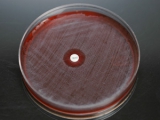Subscribe to our newsletter
Hardy Diagnostics Optochin Differentiation Disks are recommended for use in the presumptive identification of Streptococcus pneumoniae from other alpha-hemolytic streptococci. Use with metal dispenser (SD260457).
SUMMARY
Streptococcus pneumoniae is found commonly in the human respiratory tract flora, as are other streptococci. When implicated in disease states and isolated onto blood agar for identification, the hemolytic pattern this organism gives is not distinguishable from other alpha-hemolytic streptococci. Thus, differentiation and identification must be performed via biochemical and serological testing.
Sensitivity to optochin (ethylhydrocupreine hydrochloride) is a well established phenomenon for Streptococcus pneumoniae. A positive presumptive identification of S. pneumoniae is made when a well defined zone of inhibition results around the impregnated disk. Other alpha-hemolytic streptococci do not display this clear zone of inhibition when in the presence of optochin.
FORMULA
Each disk is impregnated with a solution of ethylhydrocupreine hydrochloride.
PROCEDURE
Specimen Collection: This product is not intended for primary isolation of patient specimens. This product is used in conjunction with other biochemical tests to identify cultures of isolated organism in pure culture.
Method:
1. Using an inoculating loop, select three to four well-isolated colonies of the alpha-hemolytic organism to be tested. An 18-24 hour culture (either BHI Broth, Cat. no. R20 or TSB, Cat. no. R30) of isolated organism can also be used for testing.
2. Streak the isolate onto one-half of a TSA-5% sheep blood agar plate (Cat. no. A10) so as to obtain confluent growth.
Important: Use of media other than TSA-5% sheep blood agar is not recommended, as false identification may result.
3. Using sterile forceps, place an optochin disk onto the inoculated surface of the agar.
4. Press disk gently with the sterile forceps or loop so that the disk adheres firmly to the agar surface.
5. Incubate the plate at 35 +/- 2.0 degrees C. for 18-24 hours in 5-10% CO2 enriched environment.
6. If zone of inhibition is present, measure the diameter with a millimeter ruler or caliper.
INTERPRETATION OF RESULTS
A presumptive identification for S. pneumoniae can be made if the alpha-hemolytic colony produces a zone of inhibition of 14mm or greater around the disk. Organisms producing smaller zone sizes should be tested for bile solubility. Organisms with questionable zone sizes (6-14mm) around the disk should be presumptively identified as a pneumococci only if it is bile soluble.
A non-pneumococcal alpha-hemolytic streptococci should grow right up to and under the optochin disk.
Cat. no. HDZ7011 ...................50/cartridge
Cat. no. HDZ7015 ....................5x50/cartridge







 Carrot Broth Kit
Carrot Broth Kit
 Bacitracin Disks
Bacitracin Disks